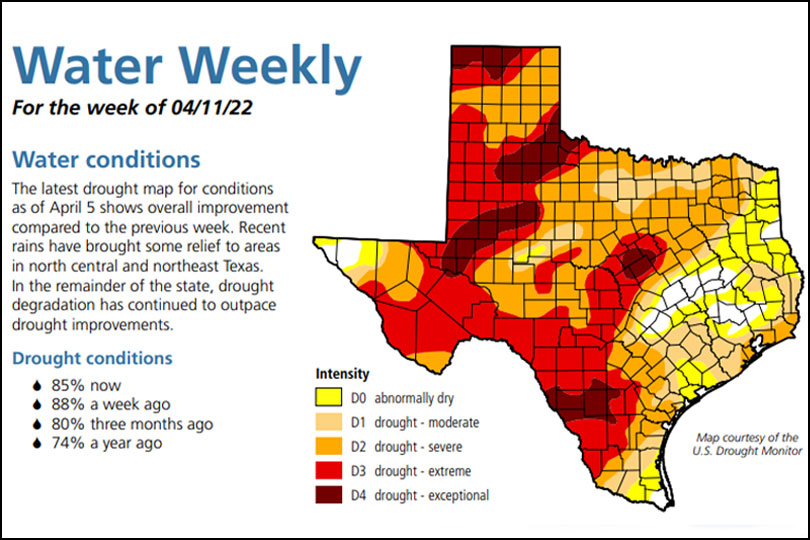By Julie Tomascik
Editor
Although spring is usually one of the wettest times of the year, that isn’t so in 2022. Parts of Texas remain parched, desperate for moisture.
According to the latest Texas Water Development Board Water Weekly report, 85% of the state is impacted by drought.
And that percentage is expected to grow, leaving farmers and ranchers concerned about crops, pastures and stock tanks.
“These ongoing drought conditions have Texas farmers and ranchers scanning the horizon for rain clouds,” Tracy Tomascik, Texas Farm Bureau associate director of Commodity and Regulatory Activities, said. “We didn’t have much moisture this fall or winter, and that dry weather has carried over into the spring.”
Soil moisture levels continue to decline, and the lack of available forage and depleting hay supplies have some ranchers planning to cull their cow herds.
“Drought is one more thing working against farmers and ranchers this year,” Tomascik said.
Although drought isn’t a new challenge for Texas farmers and ranchers, it’s another hurdle facing agriculture with rising input costs for seed, fuel and fertilizer.
“Combine the drought with high prices for fuel and fertilizer, and it becomes a very tough outlook for a good hay crop,” Tomascik said. “The same goes for farmers growing other crops. Without some good, soaking rains, this growing season becomes a lot more difficult.”
The U.S. Department of Agriculture’s latest crop progress report shows the worst winter wheat crop in 20 years. Tomascik noted the Texas wheat crop has faced a lack of moisture since it was planted last fall.
Farmers and ranchers should prepare for extended drought conditions, he said.
“Hay supplies could be tight this year if we don’t see more rainfall,” Tomascik said. “It’s important for ranchers to evaluate the carrying capacity and stocking rates for their pastures right now and make plans for ongoing drought conditions.”
Another concern is the elevated risk for wildfires.
More than 150 counties are currently under a burn ban, and Texas A&M Forest Service officials said the dry vegetation and high winds could lead to more wildfire activity across the state.
Over 100,000 acres have burned this year.
“Each day brings us closer to the next rain, but Texas needs those rains to get here in a hurry,” Tomascik said.

